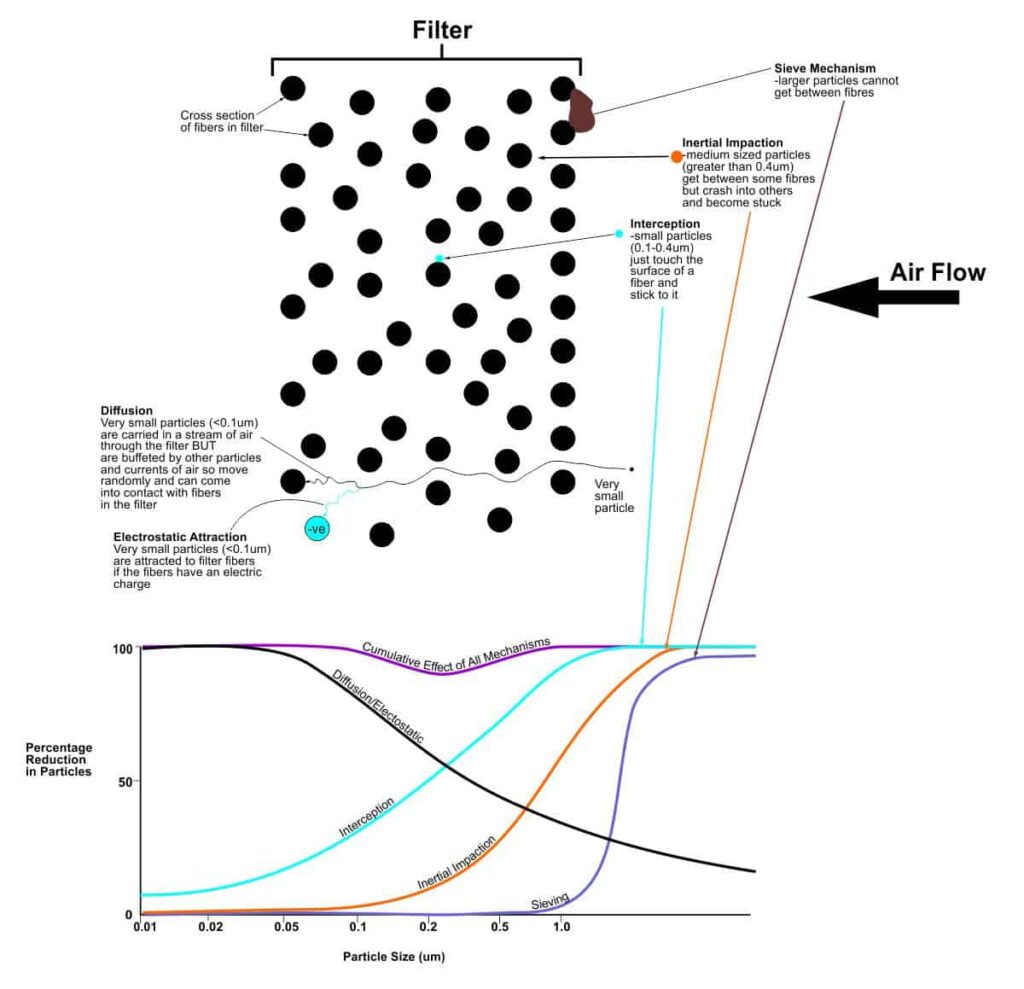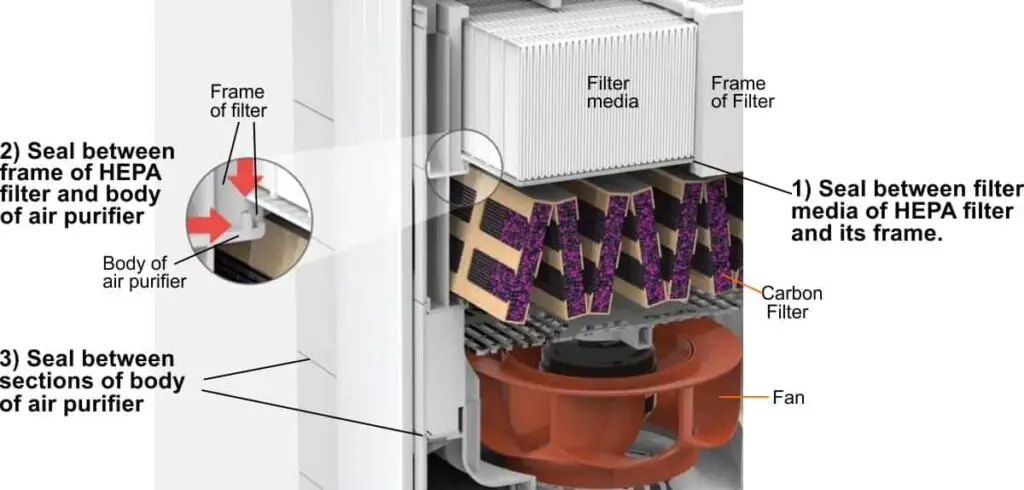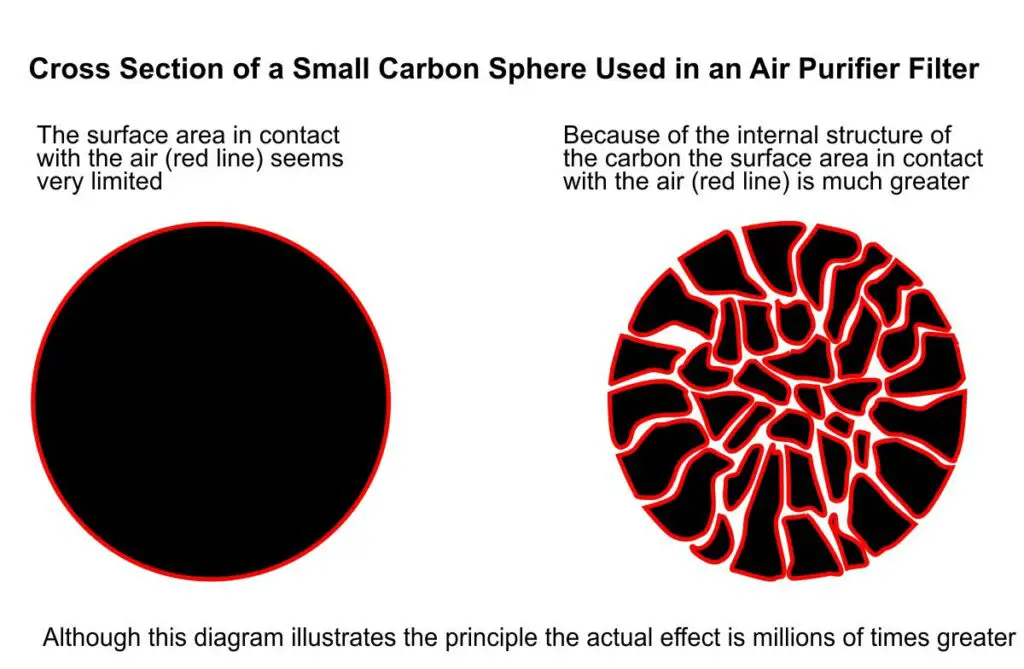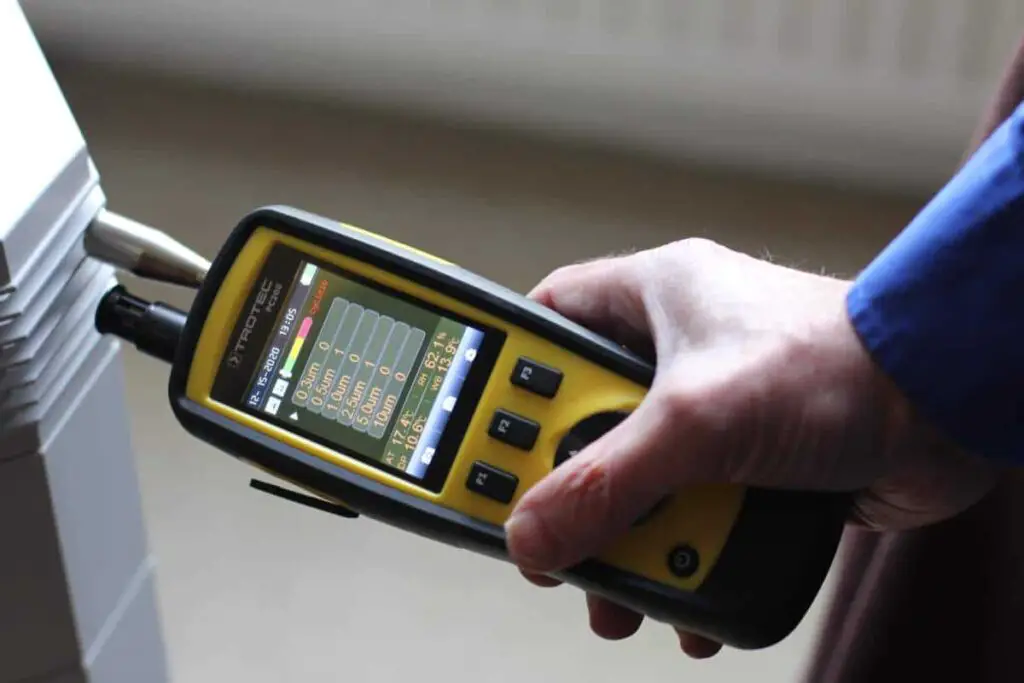Airborne particulate matter has been linked to respiratory illness and premature aging of the lungs. Particles in the air when breathed in can enter the bloodstream. They have been found in our brains and pollution is thought to be linked to an increased incidence of dementia. Airborne particles have also been found in placentas. It is possible to reduce the amount of pollutant in the air using an air cleaner-air purifier.
As a general rule air purifiers work by using an electric fan to push air through a filter. There are 2 types of filter, the most important a true HEPA filter, removes particles from the air. A carbon filter is usually also present to remove chemicals. Other technologies do not work as well.
Technologies, such as UV lamp, negative ions in an ionizer purifier but these do not work as well as a HEPA filtration for removing airborne particles and improving indoor air quality. The removal of particles is the single most important thing that an air purifier does as it is particles that are, almost always, the main hazard to human health.
I outline below how a sophisticated air purifier works so that you understand not only the basic mechanism but also what technology is available. We are fortunate to live in an age where portable air purification by a portable air purifier and reduce indoor air pollution by as much as 80-90%.
This type of air purification system can also reduce chemical contaminants from the air by incorporating activated carbon/charcoal filters.
So how do air purifiers work ?
1) Removing Particles From the Air
The most important aspect of air purification is the reduction of fine and ultrafine particles in the air. Fine particles are deposited in our lungs an ultrafine particles enter our bloodstreams and can reach our brains. There are literally hundreds of studies showing that particulate pollution is related to many heath conditions, including heart attacks, strokes and dementia.
The most effective air purifiers at reducing particles work by using a fan to push air through a filter. Air is drawn into the air purifier by a fan which then pushes the air through the filter. This is the basic mechanism, but other filters may be used in addition. Additional filters used are usually a pre-filter and carbon filter as seen in the illustration above.
To Remove Particles-a HEPA Filter is Needed
The most common concern with the effect of air pollution on health is with fine and ultrafine particulate pollution. To remove these particles a true HEPA filter or better is needed. Fan and HEPA filter technology has been shown to be much better than other technologies at removing small particles.
The larger the surface area of a HEPA filter, the more air it can process in a given time. So HEPA filters are made of fibrous material arranged in “pleats” that is folds. The pleats increase the surface area-

The HEPA standard specifies the filter will remove at least 99.97% of particles 0.3 µm in diameter. This is the size of a particle that is within the range most likely to penetrate a fibrous filter (see the dip in purple line in graph in diagram below). You should avoid any filters labelled “HEPA-type,” “HEPA-like,” “HEPA-style” or “99% HEPA” as some of these fall quite a long way below HEPA standards.
How HEPA Filters Work
We are all used to filters and have a mental model of the objects filtered out being trapped because the holes the filter are smaller than the objects that we wish to retain. So if we boil some peas and then use a calendar the kitchen to get rid of the water but keep the peas this is the understandable model will have. This is not the only way that air filters work there are 4 additional mechanisms, these have rather fancy terms these are inertial impaction,, interception, diffusion and electrostatic attraction which I explain below.
HEPA filters are made from a made from a mesh of glass fiber and polymer fibers. The reason fibrous filters can be so effective is that they are dense enough for not only the basic civil mechanism to work but also 3 other mechanisms also help filter the air –
- Sieve mechanism – this is the most obvious mechanism in which an airborne particle is too large to fit through the holes in the filter. This mechanism is very effective for particles larger than one micrometer – see the graph below. However, once particle size drops below about 0.5 µm, it becomes ineffective for most filters as the gaps between the fibers are larger than the particle size.
- Inertial impaction – medium-size particles between 0.4-1 µm have enough inertia to impact fibers of the filter and become stuck. Particles this small can get through the size of holes in the “sieve” of the filter. But unlike even smaller particles which are taken on air currents deeper into the filter, these particles have a mass to continue in a straight line and hit the fibers. If you look at the graph below, you can see that as particle size decreases, inertial impaction is much less effective.
- Interception-this applies to very small particles 0.1-0.4 micrometres. These particles are carried by air currents and did not simply crash into the fibers and become stuck. However, if they touch the surface of the fiber at all even a glancing blow, they become stuck to it. As you can see from the graph below, this exerts some clearance effect throughout the particle size range.

However none of the above mechanisms a very effective for particles less than 0.1 micrometres. These form more than 90% of the particles in the air are implicated in health problems and can even enter our bloodstream. Fortunately, there are 2 mechanisms by which fibrous filters can remove these particles -These particles are eliminated from the air by 2 different mechanisms, namely diffusion and electrostatic attraction.
4) Diffusion. Very small particles are buffeted by adjacent air particles randomly and so move in an uncontrolled zigzag fashion – “Brownian motion”. This uncontrolled motion can bring them into contact with the fibers in the filter to which they then stick, so removing them from the air.
5) Electrostatic Attraction. Some filters have an electrostatic charge on the fibers. This helps to attract oppositely charged very small particles to the fibers where they become stuck.
So A HEPA filter is formed of a tight meshwork of fibers. This leads to 5 major ways that particles interact with the fibers and are removed. Sieving, inertial impaction, interception, diffusion and electrostatic attraction. Sieving removes large particles from the air. Inertial impaction removes medium-sized particles. Interception removes small particles and diffusion as well as electrostatic attraction removes tiny particles from the air. Through these 5 mechanisms HEPA filters remove particles of all sizes very effectively.
These filters will remove cigarette smoke particles, pet dander, seasonal allergens, house dust mite particles, mold spores, allergen and many other airborne pollutants.
Pre-Filter-a Coarser Fibrous Filter
Most air purifiers have a pre-filter. The idea of this is to remove large particles from the air so that it does not block up the more expensive fine mesh of the HEPA filter. These pre-filters are often made of a material that can be vacuumed and then washed and reused. They can remove up to 50% particles before the air gets to the HEPA filter. There are even machines that can have 2 pre-filters!
Seal Between Casing and Filter
One hidden aspect of how air purifiers work is the seal between the filter and its frame and between the frame and the body of the air purifier. If there is a leak where air can get around the material in the HEPA air filter as it is under pressure, much of the air will bypass the filter. This will lead to the air purifier being much less efficient.
There are 3 seals needed-
- Between the filter media of the HEPA filter and its frame
- Between the frame of the filter and the body of the air purifier
- Between different parts of the body of the air purifier. This is because it needs to be opened to replace the filters and so when it is put back again there needs to be a tight seal.
The illustration below shows iQair’s triple sealing technology-

Fan to Push Air Through the Filter
This needs to be as powerful as possible while still being ultra quiet. It also needs to be very durable-guarantees now run for 5 years. This can be seen in the above illustration. Much refinement and engineering goes into the aerodynamics of the fan so that it is as quiet as possible. This accounts for the fan’s unusual shape in this illustration.
Are There Other Ways of Reducing Particles?-Yes but Not as Good as a HEPA Filter/Fan Combination
Other air purifiers work in completely different ways. None of these are considered adequate on their own by the EPA for air purification.
a) Free Radical Generating Air Purifiers
Free radical generators break down chemicals, viruses, smoke particles, “dust” and other things. There are reports of them being largely ineffective against particles, which are in general the primary concern for human health –
b) Ion Generating Air Purifiers-Ionic Air Purifier
These can reduce particle count in the air, although the particles are not removed from the room. They simply stick to the collecting plate or more usually to objects in the room. They then cover the room in a layer of fine dust, which is then agitated into the air when people move in the room. There are also potential health concerns with ion generating air purifiers. This is explained in more detail in this article.
c) Electrostatic Air Purifiers
These attached electrical charges to particles. The particles are then collected by plates of an opposite charge to attract them. If they miss the plates, they go out into the room and stick to other objects in the room in a way similar to static electricity. The problem with these systems is that first they are not as efficient as a HEPA filter in removing particles. Second, the particles are still in the room and will be disturbed back into the air as you walk over the floor or touch objects. You will end up with a thin layer of dust covering the walls, flooring and objects in the room.
2) Removing Chemicals From the Air-a Carbon Filter is Needed
HEPA filters part formed of inert fibers which do not remove chemicals. To remove gaseous pollutant, such as volatile organic compounds and other harmful gaseous pollutants an activated carbon filter is needed. This is because molecules of gas are so small that they will travel straight through the fibrous filters to catch particles outlined above. This type of chemical removing filter is useful in reducing odors which are in general caused by volatile organic compounds. So they help your home smell better.
They are also very important in forest fires as the smoke contains chemicals damaging to human health. I have written an article about the best air purifiers for smoke here.
The carbon adsorbs the chemicals, which means that the chemicals become stuck to the surface of the carbon by intermolecular forces. Activated charcoal has an enormous surface area 1 gram having a surface area of 32,000 square feet (3000m2).
The internal structure of the activated carbon creates this increased surface area-

For instance, the filter in the illustration below is only approximately 1 sq ft but has an equivalent surface area for absorbing gas of 80 million sq ft!

One common class of chemicals removed by this filter are volatile organic compounds, but formaldehyde, nitrogen oxide and sulfur dioxide can also be removed by it. As chemicals are the cause of odors this filter can be regarded as an impressive odor filter.
The main form of adsoption is physisorption which is due to weak intermolecular attraction and this accounts for most of the adsorption of chemicals. The other type of adsorption is chemisorption where gaseous compound reacts with the surface of the filter and is bound to it permanently by a covalent or ionic bond.
Apart from adsoption alumina pellets impregnated with potassium permanganate can be incorproated into the filter to break down formaldehyde.
Again, this type of filter can be seen in the above illustration. This air purifier is a top of the range machine and has 5.5lbs of activated charcoal “carbon” in it-lifespan of this filter is 2 years. Most air purifiers have much less than this, sometimes just a thin coating on a material filter.
Ozone can also be removed by carbon filters but it will decay naturally into oxygen.
Alumina pellets impregnated with potassium permanganate can be incorproated into the filter to break down formaldehyde.
Removing Viruses/Bacteria/Fungal Spores
HEPA Filters
Viruses are much smaller than either bacteria or fungal spores and so are the “acid test”. Some brands of HEPA air purifier are very effective at removing viruses from the air. As the EPA points out, however, this does not guarantee that someone will not catch the virus as they may breathe infected air in before it gets anywhere near the air purifier. Nonetheless, there is evidence that air purifiers do reduce transmissibility of viruses from person-to-person. Please see this post for further discussion.
UV Light
UV light can destroy a percentage of all viruses and bacteria in the air. The problem is the dimensions of a UV air purifier and speed of flow of air through the purifier limits the number of viruses and bacteria that are irradiated for long enough to damage them-please see this article-“.
Control Mechanisms for Air Purifiers
The control mechanism is not as important factor in how air purifiers work as you may think. Ideally you simply want a mode where if it is supplied by electricity it will come on. You then leave it plugged into the smart plug on the setting that is needed to purify the air in your room. Then program the plug via the smart home system to switch on at least 45 minutes before you will be in the room. It is fairly pointless having a remote control because it needs to be on for 45 minutes before you even step into the room as it takes this long for the particle count in the room to drop.
You may think that you should buy an air purifier with an inbuilt sensor but for several reasons this is not a good idea – the reasons given in this post.
For more on control mechanisms and how to use air purifiers, please read this post-“How to Use an Air Purifier“.
How to Purify Air?
As a general rule the only effective way to purify air is to use an air purifier. An air purifier will reduce the airborne particle count by more than 80%. Provided it has a carbon filter which almost all air purifiers do, it will also reduce the amount of most chemicals in the air considerably.
Upgrading your HVAC filter can make a significant difference to the airborne particle count, and it is something you should consider. However, most HVAC systems cannot take very highly specified filters without remodeling. So that they cannot clean the air as well as a dedicated air purifier. Also to be effective you would need to run the HVAC system all the time when you are in the home.
There is an urban myth that plants purify air, they do nothing to reduce airborne particle count. Also you would need a 1000 plants in a room to significantly reduce the concentration of chemicals in the air.
Conclusion-How do Air Purifiers Work?
A standard high-quality air purifier works by a fan pushing air through a true HEPA air filter. A pre-filter can be used to remove large particles to increase the lifespan of the more expensive HEPA air filter which deals with the more harmful particles. The carbon filter can also be added to remove chemicals from the air. Usually the primary concern to health is from fine and ultrafine particles in the air, and other technologies are not nearly as effective as HEPA air filters at reducing these particles.
Related Questions
Related Posts

7 Reasons Your Air Purifier is Not Working?


Why Are Air Purifiers So Expensive

Featured image-elements copyright iQair with permission

